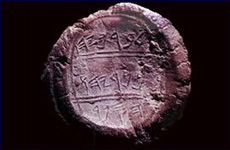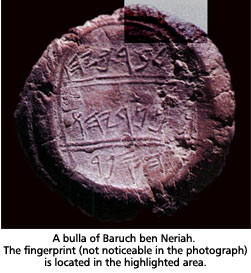 Iran’s Attack on Israel
Iran’s Attack on Israel


15 min read
Independent sources confirm many of the major and minor characters of the Bible.
The Seal of Baruch ben Neriah
How lonely sits the city that was once full of people! She has become like a widow! She, that was great among the nations and a princess among the provinces, has become a tributary. Lamentations 1:1
Those melancholy words of the prophet Jeremiah were composed from the dismal confines of a dungeon cell. The prophet of God dictated the words of doom while his protege, the scribe Baruch ben Neriah, carefully recorded them on a scroll. Baruch read the words of Lamentations before the king of Judah, Jehoakim. The thought of losing his kingdom so angered the king that he cut the scroll into pieces and threw the scraps into a fire as though that would alter the divine decree.
 Twenty-four hundred years later, a small lump of clay was discovered in Jerusalem bearing the seal of Baruch ben Neriah. The disciple of Jeremiah was suddenly and tangibly brought to life. One's imagination began to run wild. Could this be the seal that was used to authenticate the original scroll of Lamentations? There is one thing the imagination does not have to conjure. When a document was to be authenticated and rendered tamper-proof, the document was rolled up and bound by a length of cord. The knot was encased in a small lump of clay, called a bulla, which was held steady with one hand while the other hand embossed the seal onto the clay. When the bulla dried, the document was ready for delivery. It was not unusual for the fingerprints of the person holding the clay and seal to be impressed onto the sides of the bulla.
Twenty-four hundred years later, a small lump of clay was discovered in Jerusalem bearing the seal of Baruch ben Neriah. The disciple of Jeremiah was suddenly and tangibly brought to life. One's imagination began to run wild. Could this be the seal that was used to authenticate the original scroll of Lamentations? There is one thing the imagination does not have to conjure. When a document was to be authenticated and rendered tamper-proof, the document was rolled up and bound by a length of cord. The knot was encased in a small lump of clay, called a bulla, which was held steady with one hand while the other hand embossed the seal onto the clay. When the bulla dried, the document was ready for delivery. It was not unusual for the fingerprints of the person holding the clay and seal to be impressed onto the sides of the bulla.
A thumbprint can be seen on the upper ridge of Baruch's bulla, most likely the print of Baruch himself.
Sure enough! A thumbprint can be seen on the upper ridge of Baruch's bulla, most likely the print of Baruch himself. Once again the imagination begins to roam. Could there be any DNA residue of Baruch on the hardened clay?
Outside Verification
A large number of modern-day historians claim that there is no evidence that the events in the Biblical accounts from Moses, Joshua, David, through Jeremiah, and Baruch, and their successors actually happened. They claim that these leaders never existed, or that, at best, they were insignificant tribal chieftains who were later made into national heroes by writers who lived long after the alleged events. According to those historians, the events mentioned in the Bible were the products of the composer's imagination. The heroes and villains of the Biblical story were crafted for a people who desperately needed heroes and villains.
Exactly who these crafty composers were, they do not say. Another point they do not address is how was it possible for these composers to one day suddenly present to the masses their supposed history, one of which they were previously totally unaware, is beyond explanation. The creditability of this history had to have been based on the reputation of the composer or composers, composers about whom we know nothing.
However, modern-day anti-Biblicists would rather embrace the idea that the story of Joshua, David, Solomon and their successors where mythical tales concocted by obscure writers rather than yield to the possibility that the stories are true.
It was not that long ago that there was no independent outside verification for hardly any of the Biblical characters. Nowadays, almost on a yearly basis, some independent source confirms the existence of one of the Biblical characters. Below is an impressive list of 61 Biblical persons, some are kings, some are prophets, some are heroes while others are enemies. They are central characters as well as minor players whose reality can be verified by archaeological and historical evidence.
Acceptable evidence is based on three factors:
When all three factors have been met, according to the interpretation of recognized scholars, historians, and archaeologists, only then is the evidence conclusive.
The verification of the more obscure Biblical characters is the more astonishing.
To my mind, it is not the verification of the major personalities that is so impressive but rather the verification of the more obscure Biblical characters is the more astonishing. It could be argued that the Biblical stories were crafted around real kings and actual prophets who had lived and ruled in some bygone era. The names of these kings and prophets may have been retained in the conscious memory of the Biblical composers. They merely had to invent the stories, many of which were not at all complimentary to the audience to which they sought to appeal- something unheard of in the ancient world but has gained great popularity in our times. The Biblical composers would have found it necessary to add in a whole bevy of minor characters to make the story flow. These insignificant folks were totally fabricated by the composers. So goes the theory.
When outside confirmation of the minor characters surfaces, it lends great strength to those who firmly believe in the veracity and accuracy of the Biblical narrative.
The List
(*minor Biblical character)
Ahab (I Kings 16-22; II Kings 1,3-10; II Chronicles 19.21.22, etc) infamous king of Israel.
Mentioned in the Assyrian Annalistic Reports, 2,000 chariots, 10,000 soldiers of Ahab the Israelite, defeated by Shalmaneser1, alluded to on the Mesha Stele. 2
Ahaz (II Kings 15-18,20,23; Isaiah 1,7,14,38; Hoshea 1; Micha 1; I Chronicles 3,8, etc.)
King of Judah
Mentioned in the cuneiform Annals of Tiglath-pileser III. 3 Several seals and bullae bearing the name of the king Ahaz. 4
Ahikam son of Shaphan (II Kings 22,25; Jeremiah 26,29,36, 39-41,43; II Chronicles 34) contemporary of Jeremiah
Bullae bearing the name Ahikam son of Shaphan. 5
Ashurbanipal/Asnappar (Ezra 4) king of Assyria. 4:10. Asnappar Identified in Mentioned in numerous contemporary inscriptions. 6
*Azaliah son of Meshullam (II Kings 22; II Chronicles 34) "And it came to pass in the eighteenth year of king Josiah, that the king sent Shaphan the son of Azaliah, the son of Meshullam, the scribe, to the house of the Lord, saying..." (II Kings 22:3)
Bullae bearing the name of Azaliah son of Meshullum found in Jerusalem. 7
Azariah/Uzziah (II Kings 14,15) king of Judah.
Aramaic inscription on a stone plaque, found on the Mt. of Olives in Jerusalem, reads "Here were brought the bones of Uzziah, King of Judah." 8 Possibly the King Azariau of Yaudi mentioned in the Annals of Tiglath-pileser III. 9
Azariah son of Hilkiah (Ezra 7; I Chronicles 5) grandfather of Ezra, high priest.
A bulla found in Jerusalem bears the name Azariah son of Hilkiah. 10
*Baalis (Jeremiah 40) king of Ammon.
Attested to by two seals found in Jordan, the Milqom Seal and the Baalisha Seal which reads Baalisha (Baalis) king of the sons of Ammon. 11
*Baruch ben Neriah (Jeremiah 32,36,43,45) a scribe, a disciple of the prophet Jeremiah.
Several bullae bearing the name Baruch ben Neriah have been found in the archaeological City of David. One bulla bears the inscription "Baruch ben Neriah the Scribe." The stratum in which the seals were found is contemporaneous with Jeremiah. 12
Belshazzar (Daniel 5,7,8) king of Babylon.
Mentioned in numerous contemporary inscriptions. 13
Ben-hadad Dynasty (I Kings 15, 20; II Kings 6,8,13; Jeremiah 49, etc.) king of Aram
Melqart Stele mentions king of Aram, Bir-hadad. Bir corressopnds to the Hebrew Ben. Zakkur Stele attests to an Aramean royal name of Ben-hadad. 14
Ben-hadad III (II Kings 13) king of Aram, son of Hazael.
Ben-hadad son of Hazael mentioned in Zakkur Stele. 15
David (Davidic Dynasty) (Mentioned more than 1,000 times in the books of the Prophets.)
Several references in extra-Biblical sources to the Davidic dynasty have been found in recent years. 16
*Elishama (Jeremiah 36,41) scribe and servant to king Jehoiakim. A bulla dating from that time period bears the stamp, "Elishama, servant of the king." 17
Esarhaddon (II Kings 19, Isaiah 37, Ezra 4) Assyrian king , son of Nebucadnezer.
Attested to in many cuneiform chronicles. Bronze plaque in Louvre depicts Esarhaddon and his mother Nagia. 18
*Ethbaal (I Kings 16) king of Sidon.
Attested by Menander of Ephesus, summarized in Josephus' Contra Apion. 19
Gedalyahu ben Pashur (Jeremiah 38:1) antagonist of Jeremiah Attested by bulla found in Jerusalem by Prof. E. Mazar. 20
*Gemariahu the son of Shaphan (Jeremiah 29,36) servant of king Jehoiakim.
Bulla found with the name Gemariahu the son of Shaphan. 21
Hazael (I Kings 19; II Kings 8,9,10,12,13) king of Aram, enemy of Israel.
Attested by ivory fragments found in Arslan Tash22 and Nimrud. Mentioned several times in Zakkur Stele. 23
Hezekiah (II Kings 16,18-21; Isaiah 1,36-39; Jeremiah 15,26; Hoshea 1; Micha 1; etc)
Renown king of Judah. Hezekiah was unsuccessfully besieged in Jerusalem by Sennecherib.
Mentioned several times in Annals of Sennacherib. The Annals refer to the siege of Jerusalem. 24 A number of seals and bullae bear the king's name. 25
Hezion (II Kings 15) king of Aram.
Attested to in the Melqart Stele. 26
*Hilkiah (II Kings 22,23; Jeremiah 1,29; Ezra 7; Nechemiah 11,12; II Chronicles 34,35) a high priest, contemporary of Jeremiah.
A signet ring bears the name of Hilkiah the priest. Dated to the era of Jeremiah. 27
Hiram (II Samuel 5; I Kings 5,7.9.10) king of Tyre, contemporary of Solomon.
Attested by Menander of Ephesus, summarized in Josephus' Contra Apion. 28
*Hopra (Jeremiah 44) king of Egypt.
Identified with ‘Apries, pharaoh of 26th Dynasty. 29
Hoshea (II Kings 15,17,18) last king of Israel.
Attested to twice in the Annals of Tiglath-pileser III. "They overthrew their king Pekah and I (Tiglath-pileser) placed Hoshea as king over them." 30 Name found on a seal that reads, "Abdi, servant of Hoshea." 31
Jehoash (II Kings 12-14) Israelite king.
Mentioned in the Annals of Adad-nirari of Assyria and on the Tel Rimah Stele. 32
*Jehoiachin (II Kings 24,25; Jeremiah 52; II Chronicles 36). One of the last kings of Judah.
Mentioned in the Ration Tables of Babylon. 33
Jehoram II (I Kings 22, II Kings 1,3,6,9,12; II Chronicles 17,21,22) king of Israel, son of Ahab.
Alluded to on Tel Dan Stele. 34
Jotham (II Kings 15,16; Isaiah 1,7; Hoshea 1; Micha 1; II Chronicles 26,27) King of Judah.
This king is attested to by a seal recently uncovered that reads, "Belonging to Ahaz (son of) Jotham, King of Judah." 35
Jehu (I Kings 16,19; II Kings 9,10,12,13-15; Hoshea 1, I Chronicles 2,4, 12, etc)
Mentioned and depicted on the Black Obelisk. 36
*Jehucal the son of Shelemiah (Jeremiah 37) official in the court of Zedekiah.
A bulla bearing the name "Jehucal the son of Shelemiah" was discovered in the archaeological city of David in Jerusalem together with other bullae dating to the period of Zedekiah. 37
*Jerahme'el, son of king Jehoiakim (Jeremiah 36)
Bulla found with the imprint, "Jerahme'el, the king's son." 38
Jeroboam II (II Kings 9,10,13-15,17,23; Hoshea 1; Amos 7; II Chronicles 9-13) King of Israel.
Seal of Jasper found at Megiddo depicting a roaring lion and bears the inscription "to Shema, servant of Jeroboam." 39
Jezebel (I Kings 16,18,21; II Kings 9) daughter of Ethbaal king of Sidon (Phoenicia), wife of king Ahab of Israel.
Name found on Phoenician royal seal dated to the era of Ahab. 40
Menachem (II Kings 15) Israelite king.
Mentioned twice in the annals of Tiglath-pileser III as Menachem of Samariah (the capital of Israel). 41
Manasseh (II Kings 20,21,23,24; Jeremiah 9,15; II Chronicles 33,34) infamous king of Judah, son of Hezekiah.
Attested to in the annals of Esarhaddon and the annals of Assurbanipal. 42 Name very possibly appears on a royal seal, which reads Manasseh son of the king (referring to Hezekiah). 43
Merodach-baladan II (II Kings 20; Isaiah 39) king of Babylonia, on friendly terms with Hezekiah king of Judah.
Mentioned in the cuneiform texts of Tiglath-pileser III, Sargon II, and Sennacherib. 44
*Mesha (II Kings 3) king of Moab contemporary with Omri dynasty of Israel, waged war with Israel.
Attested to in Mesha Stele, Mesha waged war with an Omri dynasty king. 45
Nebuchadnezzar II (II Kings 24,25; Jeremiah 27,282934,39; Daniel 1.2.3,4,5, etc) king of Babylon, captures Judah and exiles the Israelites. Well attested to. 46
*Sarsekim (Jeremiah 39:3) official of Nebuchadnezzar II, name recently deciphered on cuneiform tablet by Michael Jursa of the University of Vienna. 47
Necho II (II Kings 23; Jeremiah 46, II Chronicles 35,36) Egyptian pharaoh during the final years of the Davidic monarchy in Judah.
Well known pharaoh of the 26th Dynasty.
Omri (I Kings 16, II Kings 8, Micha 6, I Chronicles 7,9, 27; II Chronicles 22)King of Israel, founder of Omride Dynasty
Name mentioned on Mesha Stele, dynasty (House of Omri) referred to in several Assyrian cuneiform texts. 48
Pekah (II Kings 15,16; Isaiah 7; II Chronicles 28) next to the last king of Israel.
Attested twice in the Annals of Tiglath-pileser III. "They overthrew their king Pekah and I (Tiglath-pileser) placed Hoshea as king over them." 49
Rezin (II Kings 15,16; Isaiah 7,8,9, Ezra 2; Nechemia 7) Last Aramean king of Damascus, fought with Pekah king of Israel.
Attested in the Annals of Tiglath-pileser III. 50
*Samgarnebo (Jeremiah 39) high official serving in the court of Nebucadnezzar.
A cuneiform tablet discovered in 1920 near Bagdad states that Samgarnebo was a chief official in the court of Nebucadnezzar. 51
Sargon II (Isaiah 20) king of Assyria.
Attested to in countless cuneiform chronicles. 52
Sennacherib (II Kings 18,19; Isaiah 35,37; II Chronicles 32) king of Assyria, invades Israel captures Lachish, besieges Jerusalem. Sennacherib's own chronicles and palace engravings attest to the invasion of Israel, the capture of Lachish and the siege of Jerusalem. 53
*Seraiah the son of Neriah, (Jeremiah 51) brother of Baruch ben Neriah.
Bulla bearing the name Seraiah ben Neriah found. 54
Shallum (II Kings 15) King of Israel.
Very possibly this king is the "Shallum" whose name is found on a cylindrical seal. 55
Shalmaneser V (II Kings 17,18) conquers Israel, exiles ten tribes. Attested to in the Babylonian Chronicles and in the Babylonian King List. 56
*Shaphan (II Kings 22,25; Jeremiah 26,29, 36,40,41,43; II Chronicles 34) contemporary of Jeremiah.
Name found on a number of bullae dated to the period of Jeremiah. 57
*Shebna (II Kings 18,19; Isaiah 22,36,37) Servant (minister) of king Azariah. Called the "one over the house," referring to his position as the one in charge of the affairs of the house of the king.
Engraving above a burial cave bears his name and the phrase, "The one over the house." 58 A seal also bears the engraving, "Shebna, servant of the king."
Shishak (I Kings 11,14; II Chronicles 12) king of Egypt, invaded Canaan during reign of Rehoboam king of Judah.
Invasion of Canaan by Egyptian king Shishak (Shoshenq I) attested to in Megiddo Stele. 59
So (II Kings 17) king of Egypt, contemporary with Shalmaneser V of Babylon and Hoshea, last king of Israel.
Most probably to be identified with Osorkon, king of Egypt, contemporaneously with Shalmaneser V of Babylon. 60
*Sanballat the Horonite (Nechemia 2-4,6,13) governor in Judah, contemporary of Nechemia.
Sanballat the Horonite is mentioned several times in the Elephantine Papyrus which chronicles the time period of Nechemia. 61
Tabrimon (II Kings 15) king of Aram
Mentioned in the Melqart Stele. 62
Tiglath-pileser III, also called Pul (II Kings 15,16; Isaiah 66; I Chronicles 5)
Attested to in countless cuneiform chronicles. 63
*Tirhakah (II Kings 19; Isaiah 37) Egyptian king, contemporary of Hezekiah king of Judah.
Well known 25th Dynasty Egyptian pharaoh.
*Tobiah the Ammonite (Nehemiah 2-4,6,7,13) antagonist of Ezra and Nehemiah.
Tobiah the Ammonite is mentioned several times in the Elephantine Papyrus which chronicles the time period of Ezra and Nechemia. Stanley A. Cook, The Significance of the Elephantine Papyri for the History of Hebrew Religion The American Journal of Theology, Vol. 19, No. 3 (Jul., 1915), pp. 346-38264
Zedekiah (II Kings 24,25; Jeremiah 1,21,24,27-29, 32,34,36-39,44.49.51.52 Nechemiah 10, I Chronicles 3, II Chronicles 36) last king of Judah, installed by Nebucadnesser.
Referred to in the Babylonian Chronicles of Nebucadnesser, and mentions that Nebucadnesser installed the Judean king. 65
Zedekiah the son of Hananiah (Jeremiah 36) official in the court of king Jehoiakim of Judah.
Bulla found in archaeological city of David bearing the name Zedekiah the son of Hananiah. The strata was contemporary with Jehoiakim. 66
